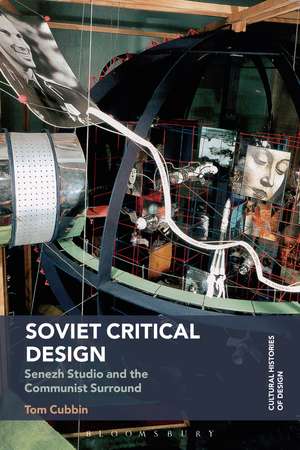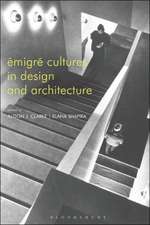Soviet Critical Design: Senezh Studio and the Communist Surround: Cultural Histories of Design
Autor Tom Cubbinen Limba Engleză Paperback – 8 mar 2023
| Toate formatele și edițiile | Preț | Express |
|---|---|---|
| Paperback (1) | 187.26 lei 3-5 săpt. | +49.11 lei 4-10 zile |
| Bloomsbury Publishing – 8 mar 2023 | 187.26 lei 3-5 săpt. | +49.11 lei 4-10 zile |
| Hardback (1) | 598.02 lei 3-5 săpt. | |
| Bloomsbury Publishing – 12 dec 2018 | 598.02 lei 3-5 săpt. |
Preț: 187.26 lei
Preț vechi: 216.43 lei
-13% Nou
Puncte Express: 281
Preț estimativ în valută:
35.84€ • 37.28$ • 29.59£
35.84€ • 37.28$ • 29.59£
Carte disponibilă
Livrare economică 24 martie-07 aprilie
Livrare express 07-13 martie pentru 59.10 lei
Preluare comenzi: 021 569.72.76
Specificații
ISBN-13: 9781350353480
ISBN-10: 1350353485
Pagini: 248
Ilustrații: 48 bw illustrations
Dimensiuni: 156 x 234 x 17 mm
Greutate: 0.45 kg
Editura: Bloomsbury Publishing
Colecția Bloomsbury Visual Arts
Seria Cultural Histories of Design
Locul publicării:London, United Kingdom
ISBN-10: 1350353485
Pagini: 248
Ilustrații: 48 bw illustrations
Dimensiuni: 156 x 234 x 17 mm
Greutate: 0.45 kg
Editura: Bloomsbury Publishing
Colecția Bloomsbury Visual Arts
Seria Cultural Histories of Design
Locul publicării:London, United Kingdom
Caracteristici
Written by a scholar who has an excellent reputation in the field, and who has already worked with us on the Bloomsbury Encyclopedia of Design
Notă biografică
Tom Cubbin is Senior Lecturer in Design Studies and head of Campus Steneby, part of the Artistic Faculty at the University of Gothenburg, Sweden. He is a design historian and has a background in Russian and Soviet history. He has contributed to the Bloomsbury Encyclopedia of Design and has had several articles published in Home Cultures, Estonian Art, and the Calvert Journal.
Cuprins
Introduction: The Communist Surround1. Art, Technology and Design in the Soviet Thaw2. Senezh Studio and the Emergence of a Critical Practice3. Semiotics, Environment and the Historical Turn4. Design and the Projective Imagination5. A Quiet Conversation Among Things: Memory, Agency and Materiality at the End of HistoryConclusionAppendix I: Complete List of Senezh ProjectsAppendix II : Key PeopleIndex
Recenzii
For many years, it seemed as if there were only two kinds of Soviet design: visionary Constructivism or Stalinist kitsch. Cubbin's vividly written and deeply researched study offers an entirely new picture. Illuminating the long history of modernism in the USSR, he examines how critical designers sought to create utopia on a human scale.
What happens when principles of Russian avant-garde of the 1920s are retooled for the needs of Soviet science and technology? In his book, Cubbin traces the emergence and demise of "technical aesthetics" created by Soviet artists-engineers in the 1960s-1980s as a communist alternative to capitalist design. Highly informative and richly documented, this book reconstructs fascinating yet barely known moments in the history of material culture and aesthetic theory of the twentieth century.
The book provides insight to the activities of Senezh studio, an important part of the USSR Union of Artists. It also explores the phenomenon of 'paper design', a particular kind of project work, characteristic of the Soviet cultural milieu. Senezh studio operated for more than twenty years, although only a fraction of its projects were ever realized. Despite this, the studio's design practices were of remarkable national importance.
What happens when principles of Russian avant-garde of the 1920s are retooled for the needs of Soviet science and technology? In his book, Cubbin traces the emergence and demise of "technical aesthetics" created by Soviet artists-engineers in the 1960s-1980s as a communist alternative to capitalist design. Highly informative and richly documented, this book reconstructs fascinating yet barely known moments in the history of material culture and aesthetic theory of the twentieth century.
The book provides insight to the activities of Senezh studio, an important part of the USSR Union of Artists. It also explores the phenomenon of 'paper design', a particular kind of project work, characteristic of the Soviet cultural milieu. Senezh studio operated for more than twenty years, although only a fraction of its projects were ever realized. Despite this, the studio's design practices were of remarkable national importance.












